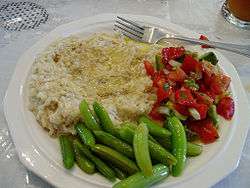Harissa (dish)
Harissa (Armenian: հարիսա harisa) is an Armenian dish from the Ararat plain. It is a thick porridge made from korkot (dried or roasted cracked wheat) and fat-rich meat, usually chicken or lamb. Herbs were substituted for meat in harissa when Armenian religious days required fasting and penance. The extremely long cooking process is an essential part of the harissa tradition. Like other ritual dishes, the time taken for preparation is part of its cherished value.[1]
Etymology

The dish has been passed on since ancient times. Stories differ as to the origins of the dish. According to Armenian lore, the patron saint of Armenia, Gregory the Illuminator, was offering a meal of love and charity to the poor. There weren't enough sheep to feed the crowds so wheat was added to the cooking pots. They noticed that the wheat was sticking to the bottom of the cauldrons. Saint Gregory advised, "Harekh! Stir it!" Thus, the name of the dish, harissa, came from the saint's own words. Harissa has been offered as a charity meal ever since.[1] The dish is traditionally served on Easter day. It is still prepared by many Armenians around the world and is also considered the national dish of Armenia.
Outside Armenia
Harissa is also very common in Lebanese villages, across its different ethnic communities, where it is usually cooked on religious occasions in a big pot in a village gathering. Additionally, Harissa is used by the Assyrians as a dish on Eeda Zoora, Christmas, and Eeda Gura, Easter. Harissa is very similar to a popular dish among Arab countries of the Persian Gulf known as harees which is made of meat and finely ground wheat.
Harissa is known for helping the Armenians of Musa Ler to survive during the resistance of 1915.[2]
It is similar to kashkeg, a kind of homogeneous porridge made of previously stewed and boned chicken or lamb and coarsely ground soaked wheat (typically shelled wheat).